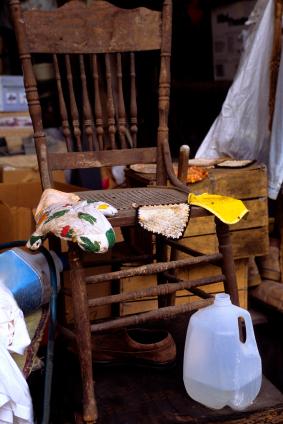Refinishing Tools – Use the right tools for your project.
Media Gallery
As with any project, refinishing is more pleasant with quality tools on hand. So what wood refinishing tools do you really need, and which ones are just nice extras? It really depends on the project. As we’ve said before, there are plenty of pieces out there that just need a good cleaning. Others need stripping and refinishing, but not much else. And then there are the nightmare projects that require extensive repairs, veneer matching, and original materials. To make things easy on you, we’ve included a section on each of these common scenarios.
Cleaning Equipment
- Vacuum cleaner with brush attachment
- Clean, soft, lint free cloths (old cotton tee shirts work great!)
- Murphy’s oil soap, Ivory soap flakes, or another mild soap (NOT dish detergent!)
- Bucket of warm water
- Mineral spirits
- Q-tips
- Superfine (0000) steel wool
- Burnishing cream
It’s always a good idea to use the least invasive method first; try removing surface dust with the vacuum first, then proceed to a full cleaning if that doesn’t help. Be especially careful not to damage painted or shellacked surfaces; apply a dab of mineral spirits to an inconspicuous area of the piece before beginning. If it softens or removes the finish and you want to keep the item’s original finish, you’ll need to take it to a professional.
Stripping and Refinishing Tools
Removing the Old Finish
- Chemical stripper(s) to soften the existing finish
- Lacquer thinner (only if you’re using a solvent-based stripper)
- A heat gun that can blow air at least 1000 degrees (for furniture with multiple layers of thick paint)
- Scraper(s) to remove the softened finish
- Steel bristled mini-brush
- Abrasives (00 steel wool, sanding sponges, sanding string, refinishing pads, and various grades of sandpaper to remove the old finish and smooth the surface of the wood)
Applying the New Finish
The tools and materials you’ll need to apply a new finish can vary greatly and depend on what type of finish you’re using. We provide a tools and materials list with each of our tutorials. In general, you’ll need:
- The finish
- Solvents for cleanup (maybe)
- An applicator (this can be an old rag, a brush, or a sprayer, depending on what you’re doing)
You’ll Also Need
- A well ventilated, dust-free area in which to work
- Eye protection and rubber gloves (get the heavy duty gloves, not the kind you’d use for washing dishes)
- Lots of clean, lint-free rags (trust us!)
- Soap and a bucket of warm water for cleanup
- A metal can to dispose of your old rags in (solvent soaked rags can spontaneously combust)
For Bigger Projects
Wood refinishing tools can be inexpensive and easy to find or, in the case of more complex restoration projects, expensive and bulky. If you’re an experienced woodworker, you may already have a lathe to reproduce broken spindles or a router to smooth damaged edges or cut new dovetails. If not, we suggest you have someone else do the work; you don’t want to spend a thousand dollars to refinish a ten dollar desk or ruin a valuable antique on your first attempt with a router. Some hand tools that might prove valuable are:
- A hammer for pounding in loose nails (cushion the blow with a block of wood so you don’t dent the furniture)
- Phillips and flat-head screw drivers for tightening loose screws
- Clamps for holding things together until the glue dries
- A saw for cutting replacement parts (power tools are fine! You’ll save yourself a lot of grief)
- A drill for creating pilot holes or reaming out dowel joints when the dowel has broken off flush. With special attachments, you can also use your drill shape and sand wood, mix up finishes, and even polish the finished piece.
- Chisels (make sure they’re sharp!) and a rubber mallet for carving and shaping wood
- An iron- it’s not just for clothes! A household iron is a must for applying many types of edge-banding and veneer.
- A wood burning tool- definitely not a necessity, but you can use it to add a unique look to your furniture.
Good Products to Have on Hand
- Wood glue
- Replacement dowels or biscuits for repairing damaged joints (you can buy these from many popular woodworking catalogues, or make your own)
- A leather or vinyl repair kit
- Replacement hardware (this includes drawer slides)
- Velvet or felt (for lining drawers)
- Wood toners, bleaches, and pre-stain conditioners (for creating special effects or working with wood that’s prone to blotchiness)
- An assortment of woods (remember that you should always match wood type on historic pieces; with newer items, you can substitute a cheaper wood and stain it to match if your budget requires)
Remember that the most important thing is the end product. If you have to use unconventional refinishing tools or experiment with techniques, that’s just part of the fun!


